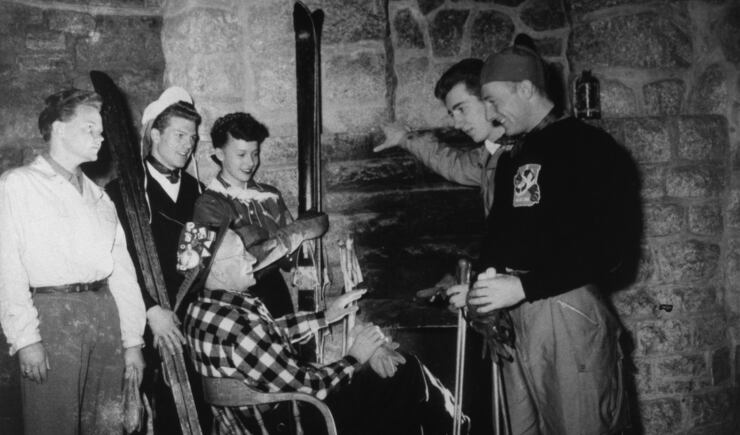ALTA — If you could bring Swen Nielson to the top of Little Cottonwood Canyon and show him that there’s a luxury hotel in the mine building where he used to work, and inside the hotel there’s a fancy restaurant named after him, you could no doubt push him over with a feather.
And not just because he’d be 165 years old.
The Snowpine Lodge, located where the blacktop stops at the east end of town, is a testament to resilience and rock-solid foundations — as well as to what a difference $50 million can make.
The oldest and most utilitarian structure in the iconic mining-town-turned-ski-mecca is also the newest and most luxurious.
It all dates back to the 1860s, when rich veins of silver gave birth to Alta and its many mines.
At the base of two of them, the Bay City and Emma, a one-story headquarters-type building was built out of rock. As the mines played out, by 1878 the structure was turned into a general store and post office. A half-century later, when the Alta Ski Area opened in 1938, it became a public shelter, named the Rock Shelter. In 1941 the shelter was renamed the Snowpine Lodge, and in 1948, a man named Paul Partenheimer took over and put in rooms where people could sleep.
Through Alta’s many iterations, through avalanches, fires, the Great Depression, the transition from mining to skiing, the rock building at the top of the road has remained untoppled.
Few structures in the state of Utah are older, and none in Little Cottonwood Canyon come even close.
If the rocks could talk, they could tell of the miners who rode the train up Little Cottonwood to go through their doors to get to work; they could tell of the years when the Great Depression shut down the entire town and the general store was locked up from 1929 to 1938; they could tell of the World War II years when the famed U.S. Army 10th Mountain Division trained on Alta’s slopes, with headquarters at the Rock Shelter; they could tell of the decades the Deseret News Ski School, responsible for putting countless thousands of Utahns on skis for the first time, operated out of the Snowpine.








Lately, the talk would be of the massive makeover that has taken place since Brent and Meg Pratt became the rock’s owners.
Brent Pratt’s Alta story is not atypical; it is the love story of thousands: Young guy comes to Utah to go to college, in his case BYU, discovers Alta skiing, and can never quite get it out of his system.
When he moved to Maryland and he and Meg started their family, their favorite ski vacations were always back to you know where.
In 2011, after a successful career in real estate development and construction, Brent heard that the Snowpine was going up for sale. He bought it from longtime owner Dwight Janerich before it could even go on the market.
After a couple of halfhearted attempts at renovations, in 2017 Brent and Meg decided to go for broke and devote $50 million to transform the Snowpine from a small economy lodge into the most luxurious property at Alta. Thirty-four rooms became 65 rooms, two levels became six levels, 20,000 square feet became 70,000 square feet.
There are those who have looked askance at the upgrade in a place as tied to tradition and the past as Alta. As travel writer Everett Potter, of Forbes magazine, wrote after the Snowpine’s soft opening in January of 2019: “‘New’ has always been a pejorative term at Alta, as has the word ‘luxury.’”
But Brent and Meg persevered, confident they knew what would fit in at Alta and what wouldn’t. They fired their East Coast designer because her design “looked like a ballroom in Bethesda,” and let their daughter take over. The result, as Hannah Dorff, the Snowpine’s director of sales and marketing, opines: “We’ve brought luxury to Alta in an Alta way.”
In the process, Brent Pratt discovered that his great-great-grandfather, the Swen Nielson mentioned at the top of this column, once worked as a teenager in the Bay City and Emma mines after emigrating to the United States from Sweden.
To pay homage, Brent named the Snowpine’s restaurant Swen’s.
In further tribute to the days of yore and ore, he named the hotel’s opulent spa the Stillwell Spa, after J.C. Stillwell, the man who managed the Bay City and Emma mines and later ran the general store.
The rock walls in the spa’s relaxation room are the very same that lined his store.
Where you could once buy a pickax and hardtack, you can now get a “Lustrous Age Defying” facial and a “Mountain Bliss” Swedish massage.
To push J.C. over, you wouldn’t need the feather.










